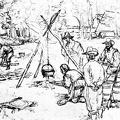Pitch and tar—used by shipbuilders from time immemorial for caulking and covering seams of vessels—were made at Jamestown as early as 1608. After the second supply ships reached Jamestown in October, 1608, one of the settlers wrote:
No sooner were we landed, but the President dispersed [as] many as were able, some for glasse, others for pitch, tarre, and sope ashes.
A month later trials of pitch and tar were carried to England by Captain Christopher Newport, as reported by Thomas Studley, one of the original planters:
Captaine Newport being dispatched with the tryals of pitch, tarre, glass, frankincense and sope ashes, with that clapbord and wainscot [which] could bee provided ... returned for England.
As pitch and tar were made in Virginia throughout the seventeenth century, mainly for exporting to England, it appears that the colonists made some profit from the sale of such products.
Pitch and tar were obtained from pine trees, one of the common trees in the Tidewater Virginia woods. Tar is an oily, dark colored, product obtained in the destructive distillation of pine wood.
- Author
- The Project Gutenberg eBook, A Pictorial Booklet on Early Jamestown Commodities and Industries, by J. Paul Hudson, Illustrated by Sidney E. King Published 1957
- Posted on
- Monday 13 April 2020
- Dimensions
- 1000*673
- Tags
- Albums
- Visits
- 1227
- Downloads
- 28
 Download Photo
Download Photo





